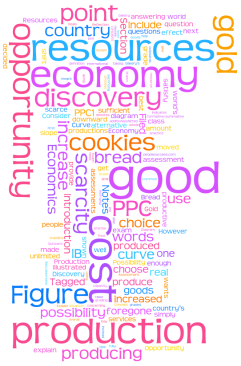Macroeconomics
Measuring national income and introduction to development
- The circular flow of income is a simplified model of the economy that shows the flow of money through the economy.
- Gross domestic product (GDP) is the total money value of all final goods and services produced in an economy in one year.
- Gross national product (GNP) is the total money value of all final goods and services produced in an economy in one year, plus net property income from abroad (interest, rent, dividends, and profit).
- Net national product (NNP) is GNP minus depreciation (capital consumption).
- Nominal GDP is GDP, not adjusted for inflation.
- Real GDP is GDP, adjusted for inflation.
- Per capita GDP is the total money value of all final goods and services produced in an economy in one year per head of the population.
- The Human Development Index (HDI) is a composite index that brings together measurements of life expectancy at birth, literacy rate, school enrollment rate, and GDP per capita to measure relative development.
Macroeconomic models
- Aggregate demand (AD) is the total spending in an economy consisting of consumption, investment, government expenditure and net exports.
- Consumption is spending by households on consumer goods and services over a period of time.
- Investment is the addition to the capital stock of the economy in the form of factories, offices, machinery and equipment which is used to produce goods and services, A fast food retailer, for example, builds a new outlet.
- An inflationary gap is the situation where total spending (AD) is greater than the full employment level of output, thus causing inflation.
- A deflationary gap is the situation where total spending (AD) is less than the full employment level of output, thus causing unemployment.
- The business cycle (trade cycle) shows fluctuations in the level of economic activity in an economy over time and suggests that the changes are cyclical. There are four stages: depression (slump), recover, boom, and recession.
Demand-side and supply-side policies
- Demand-side policies are any government policies designed to influence AD in the economy, thus affecting the average price level and real national output.
- Fiscal policy is a policy using changes in government spending and/or direct taxation to achieve economic objectives. example
- Monetary policy is a policy using changes in the money supply or interest rates to achieve economic objectives. exmaple
- Aggregate supply (AS) is the total amount of domestic goods and services supplied by businesses and the government, including both consumer goods and capital goods.
- Short-run aggregate supply (SRAS) is AS that varies with the level of demand for goods and services and that is shifted by changes in the costs of factors of production.
- Long-run aggregate supply (LRAS) is AS that is dependent upon the resources in the economy and that can only be increase by improvements in the quantity and/or quality of factors of production.
- Supply-side policies are government policies designed to shift the LRAS curve to the right, thus increasing potential output in the economy.
- The multiplier is the ratio of a change in the level of national income to an initial change in one or more of the injections into the circular flow of income (that is investment, government spending, or export revenue).
- The accelerator is the relationship between the level of induced investment and the rate of change of national income.
- Crowding out is a situation where the government spends more (government expenditure) than it receives in revenue (mainly taxation), and needs to borrow money, forcing up interest rates and “crowding out” private investment and private consumption.
Unemployment and Inflation
- Unemployment is a situation that exists when people who are willing and able to work cannot get a job.
- Full employment exists when the number of jobs available in an economy is equal or greater than the number of people actively seeking work.
- Underemployment exists when workers are carrying out jobs for which they are over-qualified, that is they are not using their full skills and abilities or when workers are employed part-time, even though they are available for full-time employment or when workers in a planned economy are undertaking jobs that would not exist in a free market.
- The unemployment rate is the number of unemployed workers expressed as a percentage of the total workforce.
- Structural unemployment is unemployment that exists when in the long term the pattern of demand and production methods change and there is a permanent fall in the demand for a particular type of labor. There is a mismatch between skills and the jobs available.
- Frictional (search) unemployment is unemployment that exists when people have left a job and are in the process of searching for another job.
- Seasonal unemployment is unemployment that exists when people are out of work because their usual job is out of season, for example, a ski instructor in the summer.
- Demand deficient or cyclical unemployment is unemployment that exists when there is insufficient AD in the economy and real wages do not fall to compensate for this.
- Real wage unemployment is unemployment that exists when real wages (wages adjusted for inflation) in the economy get pushed up above their equilibrium, either by the government or by trade unions.
- Inflation is a sustained increase in the general level of prices and a fall in the value of money.
- Demand-pull inflation is inflation that is caused by increasing AD in an economy that shifts the AD curve to the right.
- Cost-push inflation is inflation that is caused by an increase in the costs of production in an economy that shifts the SRAS curve to the left.
- Deflation is a persistent fall in the average level of prices in an economy.

Leave a comment